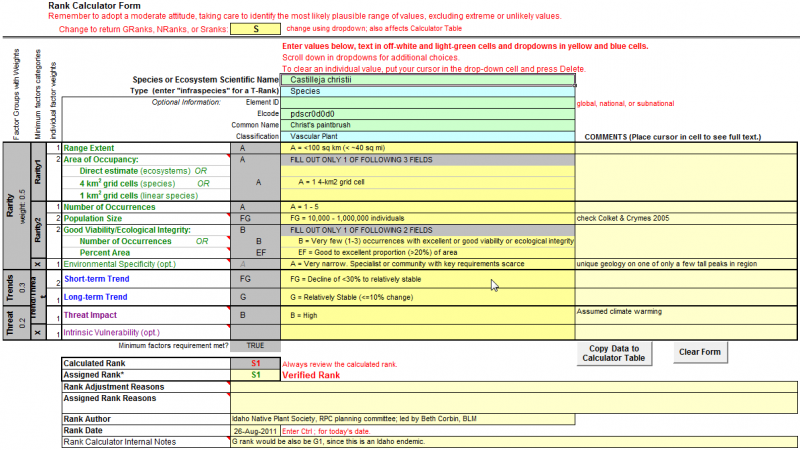Historically, IDFG Biologists used a data management system, called Biotics, to track Element information and aide in the development of conservation ranks. Biotics managed the information in the background and ranking often involved a fair amount of qualitative assessment and judgment by an expert or group. This process had issues with consistency and repeatability. In 2004, NatureServe formed the Element Ranking Working Group to address these issues and to develop a ranking protocol. The major product of this group was a ranking calculator, which IDFG biologists now rely on for assisting in the assignment of status ranks. This ranking system is intended to be free of bias, transparent to users, and allow for consistency of application within and between groups. It also provides documentation for tracking of the decision process.
What’s necessary to accurately rank species in Idaho?
The short answer is the knowledge of rarity, trends and threats for a species. NatureServe has developed a rank calculator to enable the calculation of conservation status ranks for a “unit of biological diversity”, also known as an “Element.” This Element may be a species or natural community.
Don’t you need an EO?
No, Element Occurrence (EO) records are not necessary for ranking a species or community. A collection of criteria, which can include EO’s, are used in assessing and determining an Element’s conservation status rank.
Rank Calculator:
NatureServe provides a Microsoft Excel workbook that allows for automatic calculation of an element conservation status rank from data that is entered into the forms and tables included within the workbook. The “NatureServe Conservation Status Assessments: Rank Calculator Version 2.0”, along with supporting material can be downloaded at http://www.natureserve.org/publications/ConsStatusAssess_RankCalculator-v2.jsp. Supporting materials include: Factors for Assessing Extinction Rate and Methodology for Assigning Ranks. Use of this tool allows for more consistent, accurate, repeatable and transparent ranking of species.
The rank calculator uses three categories (rarity, trends and threats), with a cumulative ten conservation status factors, of which eight are “core” factors, for assessing conservation status. These factors, by category, used to assess conservation status are:
• Rarity: Population Size, Range Extent, Area of Occupancy, Number of Occurrences, Number of Occurrences or Percent Area with Good Viability/Ecological Integrity, and Environmental Specificity (used only when the Number of Occurrences and Area of Occupancy are unknown);
• Trends: Long-term and Short-term Trend in population size or area;
• Threats: Threat Impact (generated by considering the scope and severity of the major threats), and Intrinsic Vulnerability (used only if Threat Impact is unknown).
(NatureServe 2009).
A rank can be assigned with as few as two of the eight core factors, including either: 2 rarity categories (one of which must be either Range Extent or Area of Occupancy), or 1 rarity and 1 trend or 1 threat category.
Example:


